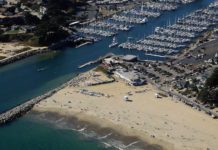The Board of Directors of the San Lorenzo Water District voted last week to declare its original home – and the home of its predecessors – as “surplus property,” with the intent to sell the small frame administration building on Highway 9 in Boulder Creek.
Former board president and local historian Randall Brown told the directors at their July 20 meeting that the building at 13060 Highway 9 is the oldest building in Boulder Creek. Engineer William Fisher told the board the building is unsafe, fails to meet fire and county and state codes, as well as federal disability laws, and cannot be renovated.
The directors hope to move its administrative staff to temporary leased quarters while the district undertakes a full-scale, three-month review of new office opportunities. The water board rejected a proposal by Fisher to also sell an office building the district owns at 12788 Highway 9.
Brown wrote this piece for the Press Banner, based on his research and presentation to the water board.
The San Lorenzo Valley Water District faces a variety of stewardship challenges. In addition to its responsibility for thousands of acres of watershed lands, it also owns and occupies the oldest building in Boulder Creek.
One of the first investors in the new town of Boulder Creek nearly 130 years ago was Howard W. West. His real estate speculations included a lot on the northeast corner of Central Avenue (Highway 9) and Lomond Street – current home of the administrative office of the San Lorenzo Valley Water District.
In April, 1889, a “hop” was held to celebrate the opening of the “West Building” at that corner. That October, the local post office moved into half of the storefront.
The famous fire of 1891 destroyed all but one building in downtown Boulder Creek but stopped short of Lomond Street. Among the casualties was Howard West’s hotel. His creditors soon closed in the winter of 1894, and the sheriff sold the West building to a Santa Cruz bank.
In April, 1897, the post office moved to a new building. The adjoining grocery expanded into the corner building – the first of many remodels.
When the store closed, Howard West rented his old property as a harness shop for a year. Jacob Hartman purchased the building from the bank in 1901, but shared ownership with his brothers, Isaiah and Dan.
In 1906, A. C. Josselyn, a refugee from San Francisco, rented half of the structure as a cigar factory.
After his death in 1910, C.S. Perkins, the tenant of the adjoining plumbing shop, created ”the Central Garage”, building an addition to house a Studebaker “buzz wagon” and a 14-passenger autobus to ferry tourists to and from the Big Basin Park.
After a suspicious 1915 fire, Perkins moved down the road.
Isaiah Hartman then decided to remodel the building to suit his own needs. Hartman and his partner, W. B. Peery, owned lumber tracts and, promoted subdivisions on the cleared land. The enclosed garage became a real estate office. In 1917, Hartman and his wife enabled the establishment of a Boulder Creek branch of the Santa Cruz Library in the older half of the building.
Prohibition proved beneficial to the Boulder Creek economy. It is possible that Hartman, whose brother owned a speakeasy in Ben Lomond, dabbled in the liquor business—the vacated library rooms would have made a convenient depot, complete with a new two-car garage in the rear.
In February 1926, the Santa Cruz Utilities Company, formed by a merger of the Boulder Creek, Brookdale, and Ben Lomond water and electric companies, purchased the Hartman building. The old store became a showroom for electric appliances.
Two years later, at the height of the stock market boom, the local firm and the building fell into the hands of the Foshay Company of Minneapolis. The out-of-town company collapsed in 1929, resulting in eight years of bankruptcy for their local subsidiary, “Public Utilities California Corp.”
While its remaining employees struggled to maintain pipelines and other infrastructure, the company’s headquarters suffered from neglect.
A decade of poor service and unheeded complaints inspired concerned citizens to begin a campaign for public ownership.
Attempting to convince the voters that the creation of a water district was unnecessary, Public Utilities California began an improvement campaign in 1939.
Part of the public relations drive was a remodel of its building. An estimated $1,000 was spent on this project, but in 1941 local voters approved the creation of the San Lorenzo Valley County Water District.
For 25 years the public agency worked to take over the water business from the corporation, now known as Citizens Utilities. The Boulder Creek building continued to serve as headquarters until the water district won the fight for control in 1965. As part of the deal, Citizens Utilities turned over the office building to the water district, but charged extra for the furniture.
Until 1993, when the district shifted its operations center to a converted gas station across the street, both office and outside workers shared the increasingly cramped space. After the sale of the Waterman Gap property in 2000, the board of directors commissioned a study to determine the future of the original building. The negative report convinced the board that the building should be abandoned. But today, after more than 50 years, the San Lorenzo Valley Water District can still be found at the old stand













